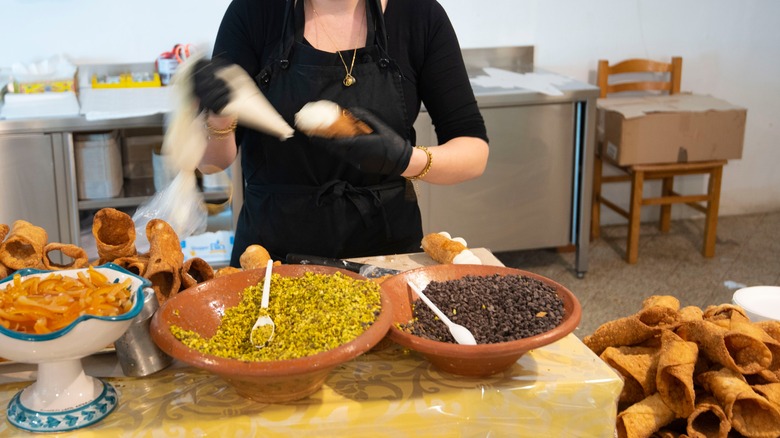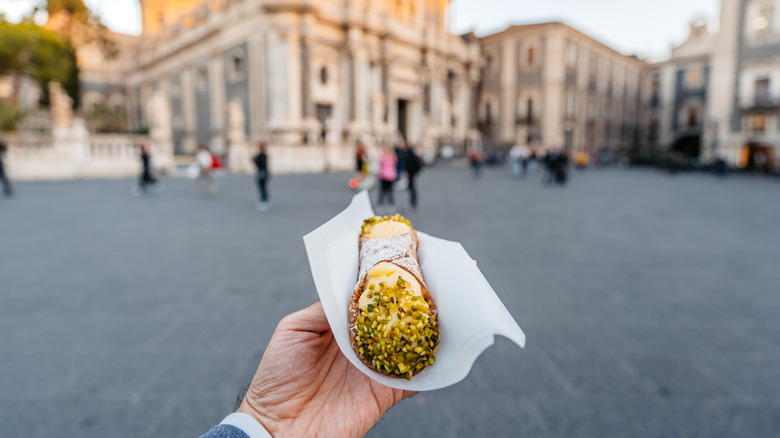When it comes to iconic Italian desserts, the cannoli reigns supreme. Originating from Sicily nearly 1,200 years ago, this sweet, creamy treat has captured the hearts of dessert lovers worldwide. Made of a crispy fried dough shell shaped like a bowtie (called “scorza” for “crust”) filled with a blend of ricotta cheese and sugar, authentic cannoli or cannolo (that’s singular for cannoli) are a hallmark of Italian pastry craftsmanship. However, tourists flocking to Italy in search of the perfect bite should be wary — not all cannoli are created equal; some are better, and some far worse. There is a specific type of cannoli that discerning visitors should avoid to ensure they experience this delicacy as it was meant to be enjoyed.
The cardinal sin in cannoli preparation is the use of pre-filled shells. Authentic cannoli are filled fresh, moments before they are devoured. This practice ensures that the shells retain their signature crispness. Once filled, the moisture from the ricotta begins to soften the shell. If left to sit for more than 30 minutes, the shell becomes soggy, compromising texture and flavor. Eateries that pre-fill their cannoli often do so to save time and manage their stock, but this convenience comes at a significant cost to quality. Tourists may encounter these pre-filled cannoli in settings like busy tourist spots or large bakeries that serve a high volume of customers. Check out our guide on how to avoid tourist traps in Europe to save your cannoli tastebuds and travel wallet!
How to spot authentic cannoli in Italy

To ensure you’re getting the real deal, there are several indicators to look for when choosing where to indulge in a cannoli. Many local Italians say that real cannoli don’t exist in Rome, Venice, or Milan, but only in Sicily. The ultimate destination for the cannoli pilgrim is the small town of Piana degli Albanesi in Palermo, where small artisanal bakeries, such as Extra Bar Petta, pipe the very best on demand. Moreover, there is no such thing as a “Cannoli Shop” in Italy. Seek out smaller, local pastry shops or cafés — “pasticceria” in Italian. These places typically take pride in their craftsmanship and fill their cannoli to order.
Another tip is to observe the setup of the pasticceria. If you see the shells displayed empty and the filling kept in a separate container, it’s a good sign that the cannoli are filled fresh. Some places might fill the cannoli right in front of you, providing a guarantee of quality and also a bit of culinary theatre. Additionally, engage with the staff. Ask about their cannoli and whether they fill them on the spot; order like a local and request that your cannolo (or cannoli) be filled fresh. Most honest shop owners will be pleased to do so and discuss their methods and the quality of their ingredients — another sign you’re in the right place. Always check the menu for tourist trap red flags and read online reviews (bonus if they’re written in Italian).
Quality ingredients and regional variations

The quality of the ingredients is another crucial aspect of the genuine cannoli experience. True Sicilian cannoli are filled with ricotta made from sheep’s milk, which is creamier and fresher than cow’s milk ricotta, often used in lesser-quality versions. There is even a traditional seasonality to cannoli, as prime-time cannoli can be enjoyed only from autumn to spring when the Sicilian sheep have the green grass pastures needed to produce the best milk. The ricotta should be subtly sweet, sometimes enhanced with vanilla or a touch of cinnamon, and not overwhelmingly sugary. Good cannoli may also contain mix-ins or toppings like chocolate chips, candied orange peels, and nuts, but these should complement, not overpower, the delicate flavor of the ricotta.
While in Italy, adventurous eaters should explore some mouthwatering regional variations of the cannoli. Though the classic version hails from Sicily, other regions offer twists on this beloved dessert. Variations might include different liquors, essences, or toppings to flavor the ricotta filling, providing a unique taste that reflects local traditions and ingredients. For example, they love adding dried fruit in Palermo, while in Ragusa, cow’s milk takes precedence over sheep. The best cannoli will always be the ones where every component — the shell, the filling, and the garnishes — are given equal attention, making you go “holy cannoli!” when you take that first bite. In Italy, where food is both an art and a passion, settling for anything less than the best is simply unappetizing.

